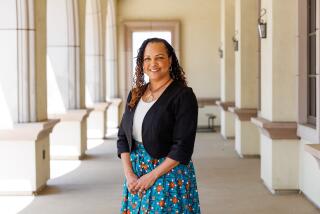Class of Equals : Peer Tutors Teach, Learn From Disabled Students
- Share via
Even before the recess bell finished ringing, students at Moorpark’s Flory Elementary School were already plopping into swings, staking out turf on the blacktop, laying claim to one of the tetherball courts lining the playground.
The only thing that held back 10-year-old Megan Devore was her wheelchair.
Megan’s teacher, Joan Hendrickson, brought her out of the classroom for recess with the other severely disabled children in her special education class.
The five students have a range of disabilities--including severe cases of autism, Down’s syndrome and cerebral palsy--that make learning difficult and communicating a challenge.
To help her pupils learn even rudimentary lessons, Hendrickson has been turning to the other students for help.
After recess starts, it isn’t long before a student comes forward asking to play. Ricky Rini, 10, dashes up to Megan, asking her if she would mind if he pushes her wheelchair. He is one of about 50 students used as peer tutors in Hendrickson’s class.
Despite her limited speech, she communicates just what she wants on the playground with a garbled but loud, “Go!” and Ricky wheels Megan to her favorite spot--a circle track painted on the asphalt. At her request, he pushes her nonstop in a circle for about five minutes.
Then he is spelled by another student. Watching the two play, Ricky said he likes helping Megan and the other students in Hendrickson’s class.
Besides joining them at recess, Ricky, like the other volunteers, will spend about half an hour each week helping one of the special education students master skills such as using money, writing out their addresses, or simply identifying the letters in their names.
Ricky has also picked up that the learning goes both ways as the students try to communicate with each other.
“Sometimes it’s hard to communicate,” he said. “Like Eric is deaf, and I only know how to say a couple of things in sign language, but I’m learning more.”
The trend in many school districts has been to include disabled students in regular classes. Nearly 70% of Ventura County’s 13,000 special education students are already integrated into regular classes. But the severity of some disabilities requires that some students have intensive attention, so about 1,000 severely disabled students spend all or nearly all of their time in special programs run by the county.
In the past, the severely disabled students in Moorpark were bused to special classes outside the district. But now the county pays for classes on Moorpark campuses at all grade levels. The special education students are mixed with the regular student body as much as possible--in the classrooms, cafeterias and playgrounds--and Hendrickson takes the extra step of asking students to volunteer to help tutor.
“What we found is a lot more learning takes place when (the special education students) have kids from the regular classes work with them,” she said. “You know, the other thing is that a lot of times these kids are shut in at home and they need friends. Now when they go around school the other kids know their names, and they say ‘Hi.’ It means a lot.”
In the classroom, Hendrickson’s students will often imitate the tutors, picking up language skills much more quickly than if they just had a speech teacher.
The students from the rest of the campus seem eager to help, Hendrickson said. After a video presentation at the beginning of the year in which each of the special education students was introduced, Hendrickson asked for volunteers. She needs only about 50 a semester, but the response from the 600 or so students on campus has always been overwhelming.
“I wouldn’t have a problem getting 100 students to volunteer,” she said. “I already have more than I’ll need signed up for next semester.”
The students often have a lot of questions and respond with a mix of emotions to the handicaps they see. Hendrickson has a collection of written reflections from students who volunteer for the program. One wrote about the tutoring, “It’s fun going . . . because I feel like I am a teacher.”
That feeling, says Hendrickson, brings out the best in many students.
But dealing with a child’s disabilities can also be difficult for the students, who start to feel empathy for the other children.
After 9-year-old Lamar Hendricks came to tutor and saw that one of the students had to be fed through a tube in his stomach, he told his teacher he didn’t know how anyone could handle that. But the experience seemed to make him work that much harder at tutoring and his own schoolwork.
“I got in trouble on the playground a couple of times,” he said. “Since I’ve been coming here I don’t get into trouble anymore.”
It is but one testimony, but one that Hendrickson said is often repeated.
“I have never had a bad tutor,” she said. “It doesn’t matter how they’re doing academically. A lot of times a kid who gets into a lot of trouble will come in here and turn himself around. I don’t see those problems here. I think they get a lot of self-esteem working here. With my kids, they get a chance to shine.”
More to Read
Sign up for Essential California
The most important California stories and recommendations in your inbox every morning.
You may occasionally receive promotional content from the Los Angeles Times.













